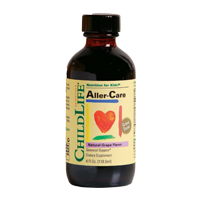適合歲數: 1y-12y
產品特點:自然的葡萄味。
Suggested Use:
For children 1-2 yrs: ½ teaspoon 3x daily
For children 2-4 yrs: 1 teaspoon 3x daily
For children 4-12 yrs: 1 -2 teaspoons 3x daily
Shake well before use.
Store in a cool dry place away from sunlight.
Give directly or mix with your child’s favorite drink.

ChildLife uses only the highest quality ingredients. Gluten free, casein free, alcohol free. Contains no milk, soy, eggs, yeast, wheat or corn. No artificial colorings, flavorings or sweeteners.
*This information has not been evaluated by the Food and Drug Administration. These products are not intended to diagnose, treat,cure or prevent any disease.
References:
Amla extract
Mast Cells and action of Flavonoids J Allergy Clin Immumol 1984.
Kumar S. Nayaka H. et al., “Free and bound phenolic antioxidants in amla (Emblica officinalis) and turmeric (Curcuma longa)” Journal of Food Composition and Analysis Volume 19, Issue 5, August 2006, Pages 446-452.
Bhattacharya A, Chatterjee A, Ghosal S, Bhattacharya SK. “Antioxidant activity of active tannoid principles of Emblica officinalis (amla).”
Elderberry extract
Zakay-Rones Z., Thom E. et al. “Randomized study of the efficacy and safety of oral elderberry extract in the treatment of influenza A and B virus infections.” J Int Med Res. 2004 Mar-Apr;32(2):132-40.
Youdim K., Martin A., Joseph J., “Incorporation of the elderberry anthocyanins by endothelial cells increases protection against oxidative stress.” Free Radic Biol Med. 2000 Jul 1;29(1):51-60.
Zakay-Rones Z., Varsano N., Zlotnik M., “Inhibition of several strains of influenza virus in vitro and reduction of symptoms by an elderberry extract (Sambucus nigra L.) during an outbreak of influenza B Panama.” J Altern Complement Med. 1995 Winter; 1(4):361-9.
Bromelain
Bromelain; a literature review and discussion of its therapeutic applications. Alt Med Rev, 1996.
H.R. Maurer, “Bromelain: biochemistry, pharmacology and medical use.” Cellular and Molecular Life Sciences Volume 58, Number 9 / August, 2001.
Guo R, Canter PH, Ernst E. “Herbal medicines for the treatment of rhinosinusitis: a systematic review.” Otolaryngol Head Neck Surg. 2006;135:496-506.
Gruenwald J, Brendler T, Jaenicke C, eds. “PDR for Herbal Medicines” Third Edition. Thomson PDR, Montvale NJ, 2004.
Proanthacyanadins
Cos P., De Bruyne T., Hermans N., “Proanthocyanidins in health care: current and new trends.” Curr Med Chem. 2004 May;11(10):1345-59.
Gonzalves C., Dinis T., Batista MT. “Antioxidant properties of proanthocyanidins of Uncaria tomentosa bark decoction: a mechanism for anti-inflammatory activity.” Phytochemistry. 2005 Jan;66(1):89-98.
Zinc gluconate
Hulisz D. “Efficacy of zinc against common cold viruses: an overview.” J Am Pharm Assoc. 2004 Sep-Oct;44(5):594-603. Sazawal S, Jalla S, Mazumder S, Sinha A, Black RE, Bhan MK. “Effect of zinc supplementation on cell-mediated immunity and lymphocyte subsets in preschool children.” Indian Pediatr. 1997 Jul;34(7):589-97.
Mossad SB, Macknin ML, Medendorp SV, Mason P. “Zinc gluconate lozenges for treating the common cold. A randomized, double-blind, placebo-controlled study.” Ann Intern Med. 1996 Jul 15;125(2):81-8.
Vitamin C
Hemilä H. “Vitamin C supplementation and common cold symptoms: factors affecting the magnitude of the benefit.”Med Hypothesis. 1999. Vol. 52 , Iss. 2 , Pg. 171-178.
Douglas RM, Hemilä H, Chalker E, Treacy B. “Vitamin C for preventing and treating the common cold.” Cochrane Database Syst Rev. 2007 Jul 18;(3):CD000980.
Sasazuki S, Sasaki S, Tsubono Y, Okubo S, Hayashi M, Tsugane S. “Effect of vitamin C on common cold: randomized controlled trial.” Eur J Clin Nutr. 2006 Jan;60(1):9-17.
Hemilä H. “Vitamin C supplementation and respiratory infections: a systematic review.” Mil Med. 2004 Nov;169(11):920-5.
Hemilä H, Louhiala P. “Vitamin C for preventing and treating pneumonia.” Cochrane Database Syst Rev. 2007 Jan 24;(1):CD005532.

